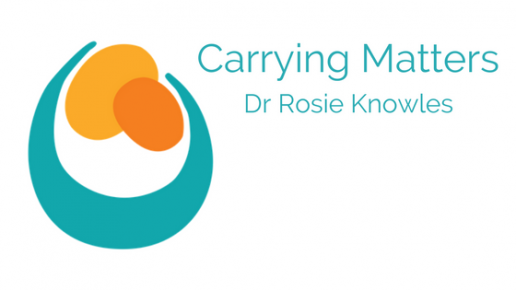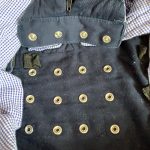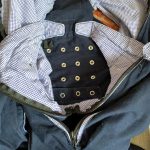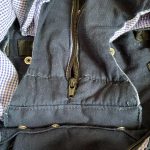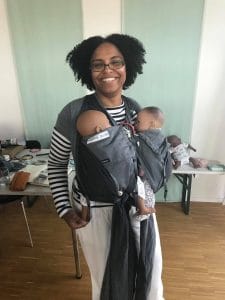So you've got more than one baby! Twins, triplets or more? Wondering about tandem babywearing (carrying multiple children at once)?“Is carrying them in a sling possible?” “Is it safe?” “What sling do I need or want?” “Where do I start with babywearing twins, or with carrying a toddler and a baby?”
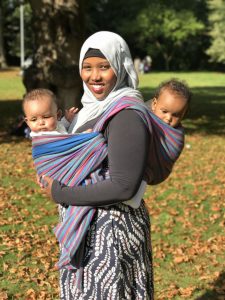
There is no doubt that carrying more than one child is one of the things that can baffle and inspire people at the same time, from the practicalities of it to the beauty of two babies in one sling.
Why carry more than one child?
When people think of carrying multiple children they often think of carrying both babies at once, this is called “tandem carrying” or “tandeming”, however, it is not necessary to tandem carry every time, or even at all! Being able to carry one at a time will free up your arms, meaning you are able to look after both babies at the same time, keeping one soothed while meeting the other’s needs.
This goes along with all the other many benefits to babywearing that applies to one child and their caregivers. More in depth information about all of these can be found in these articles here and here.
Babywearing can also be an amazing tool to use if you also have older children, to help engage in play with them whilst the younger babies are happily in the sling. There can be some limitations with this as it can be difficult to keep older children in check when tandem carrying, due to some of the movement /speed restrictions!
How does it work?
For new parents the idea of learning to use a sling can be daunting and especially for new parents of multiples due to the huge range in choice and the practical logistics of it. The best thing to do is to learn to carry one baby safely and with confidence first, then move on to tandem carrying when needed.
But how do I learn to use a sling?
There are so many ways to learn now from one-to-one support (if you are local to us in Sheffield, the Sheffield Sling Surgery bookings are here) to self-learning from online videos (do choose channels made by experienced and reputable teachers!)
One of the main benefits of choosing professional support and learning one-to-one is the hands-on and emotional support this service offers. This can range from learning your very first ins and outs of carrying your children, getting a fit check and some tweaks, to expanding your carrying knowledge as you begin to learn your preferences, all with a listening ear and an experienced guiding hand.
The most important thing is to ensure that you are carrying safely. Feeling safe and confident with professional support can be one of the most helpful inputs for beginning to develop that amazing bond with your child/ren.
Booking a consultation will help you to gain these skills. Consultants train with various schools of babywearing and they have a wealth of knowledge and experience in carrying children as well as teaching you the practical skills, they may call themselves babywearing or carrying consultants. They have a passion for carrying children and the technical knowledge to know how to carry in a variety of ways, and will support you in however you want to carry.
Laura; “I carried my first baby everywhere and anywhere so I knew I wanted the same when the twins came along but the idea filled me with all the anxiety! I booked onto a couple of consults and turned up at the drop in sessions at the library to nosey at and try out the styles.
When I first carried both babies I used the stretchy wrap which I was taught to use at a consult. We went through the basics first and got one baby secure then onto adjustments for twins. Each step was explained and I was helped to iron out the niggles to get them and me comfy. The consultation was invaluable! It made getting out and about so easy. Now they’re bigger I’m using all the slings and wraps thanks to more consults and guidance. I love babywearing!”
So what are the options when carrying multiple children?
There are a vast number of ways to be able to carry multiple children. Some carriers are designed to carry two children at the same time, others can be adapted to suit the needs of your family.
We will first look at the individual carriers that can be used in different ways to carry single or multiple children, then we will look at carriers that have been made specifically to carry twins. We’ll explore using two similar carriers to carry multiple children, and then lastly we will consider the mix and match approach of using different types of slings at the same time!
Individual carriers that can be used to carry one or both children
Stretchy Wrap
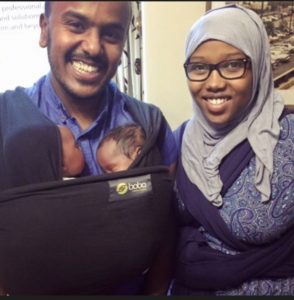
A stretchy wrap is a length of fabric, usually made of soft and stretchy machine knitted cotton, that is usually between 4 and 5m long and about half a metre wide. Some have bamboo blended in with the cotton, which adds to the softness and comfort, and some have a small proportion of spandex, which adds to their elasticity and stretch.
When choosing a stretchy wrap it is best to get your hands on a few different brands as they vary in stretchiness and therefore give a different level of support and comfort when two babies are being carried, due to the increased weight.
The best thing to do when preparing to carry twin is to get to grips with using the sling for one baby, usually the pocket wrap cross carry. Our photo tutorial for putting on a two way stretchy wrap in a pocket wrap cross carry (PWCC) with a single baby can be found here. Once you have mastered this, then you can learn to get both in at the same time (you will need to allow more space for both babies!)
However, when it comes to putting both babies into a stretchy wrap, it can be challenging to learn all of it from a video (many videos are best used as aide memoires once the skill has been learned). Furthermore, some twins may be under the recommended weight limits for the wrap, so it would be beneficial to get in contact with your local babywearing team and book some in person support with them to make sure that everyone is safe.
This is a beautiful video done by LeKeta Kemp from Tandem Trouble, it shows her demonstrating a pocket wrap cross carry for twins with a sturdy stretchy wrap.
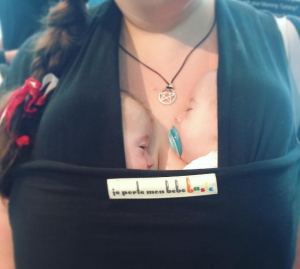
Pros and cons of using a stretchy wrap for twins
Pros
- Once tied, a stretchy is a poppable carrier so can be put on at the start of the day and babies can be taken in and out of the wrap without needing to retie each time.
- It can be used for one or both babies.
- It can feel more affordable than other options.
Cons
- It can be hard to get the hang of it when you are first starting out, as there is when learning any new skill. However with practice it will soon become manageable.
- It can be harder for people with smaller frames and as babies get bigger.
- Some people can start to run out of space on their front with two babies!
Close Caboo
The Close Caboo is a hybrid stretchy carrier, the fabric is sewn into a pre-arranged shape (similar to a PWCC), which can be slipped on over arms and head, to offer two ready made hammocks for baby to rest in.
A Close Caboo can also be used with twins in the same way as a stretchy wrap. It has some of the structure sewn in, so is already partially set up for use. It has two pockets, both adjustable by tightening the fabric through the rings at the side, and then a third layer to tie over the top for security.
The advantage of the Caboo is that it can be adjusted to size, then popped on. With a few minor adjustments it can be used for either one or both babies, each pocket can be adapted to fit their different sizes. It is also really easy to adjust when the babies are in the Caboo, as the rings can be used to pull the fabric tighter if needed.
You can find our photo tutorial for getting one baby into a Close Caboo here. With two, each baby sits in separate pockets and they are placed in one by one, with the third layer tied on around both at the end.

Pros and cons of using a Close Caboo for twins
Pros
- The fabric is a one-way stretch – this can mean less of a slumping risk as babies get bigger and can feel sturdier.
- It is really easy to adjust when the babies are in.
- It offers a quick and easy front carry.
- It is easy to use and learn for one baby as well as two.
Cons
- The panels are thinner when compared to a stretchy wrap, this means it can be harder to get the position just right to avoid red marks at the knee.
- It is a little more expensive than a stretchy wrap.
Woven Wraps
A woven wrap is a fantastic tool for babywearing, it can be used in so many ways for one or two children of the same or different ages as well as being used alongside a different carrier. Essentially a woven wrap is one long piece of fabric that has been woven specifically to carry children, they vary in length, known as their size (most commonly from 1 to 8), and what length is used comes down to personal preference and what you are going to use the wrap for. You can find more information about woven wraps here.
A woven wrap can be used from the very start of your carrying journey with twins, either having both on the front (a front tandem carry) or one on the back and one on the front. If you are planning to do this then a consultation is needed to learn these skills. Back wrapping a small baby is a skill that takes a lot of practice in itself and requires professional support and guidance, and it is best to get to grips with front carries with the woven wrap first.
Front tandem carries
There are many options with woven wraps for front carrying two babies of a similar size until you run out of room! One of these options is the Jasmine’s Hip Carry which is usually done with sling rings.
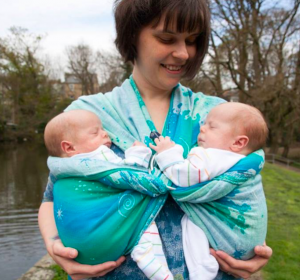
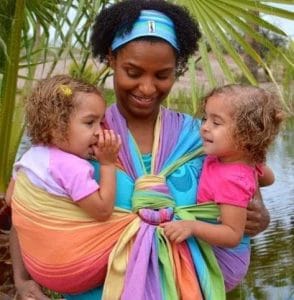
What makes it so special? The Jasmine’s Hip Carry is done using one woven wrap with either one or two rings. Once prepared the wrap can be left threaded through the rings so it is pre-tied and removed for wear at a later time, each side of the carry can also adjusted to suit the size of each baby. This can be tricky to master but lots of practice will help!
This video by LaKeta from Tandem Trouble is a great video to see the logistics of a Jasmine’s Hip Carry with two rings.
Other options are the Amanda’s Tandem Hip Carry,(from Tandem Trouble), which is a ringless carry that knots round the back. There is also a twin version of the popular Front Wrap Cross Carry (from Little but Once), this has no ring and is tied at the front or back depending on what size wrap is used.
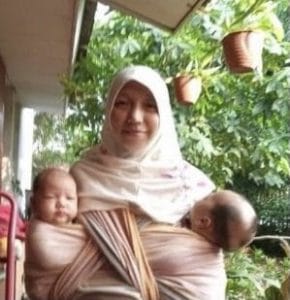
Front and Back Tandem Carries
A front and back tandem carry can be used for children of the same or of different ages.

This is because woven wraps are a collection of individual strands meaning they can be carefully tightened section by section to ensure your baby is fully supported from neck to knee pit, with the airway open, respecting the natural gentle curved J and M shaped position. As these back carries tend to be done high up on the parent’s back, caregivers are able to see their baby’s face and feel their breathing on the back of their neck.
When back carrying a newborn, most people will choose a simple rucksack carry, which is just a single layer across the baby, ensuring there is less pressure for tiny bodies. However, getting your baby up on your back can be a challenge and is something that is best learned with the help of a professional. This video from Wrap you in Love will give you an idea of the safe way to do this if you would like to see how it works.
Once you have one child up on your back, you can use the rest of the long wrap, tied in a crossed across the chest ‘Tibetan’ finish, to pop your little one into the cross passes. This can also be done with two different wraps, mostly done when a toddler is on the back in a carry with multiple passes and a short wrap is used as a simple sling pass, passed through the wrap and tied under their bum, as seen below.

Doing a front and back tandem carry can be a lifeline for some parents. Life with small children can often feel very hectic and being able to keep both children close at the same time can be a fantastic parenting tool.
Anna Nham; “Solo parenting with a toddler and a baby and the older one refuses to walk home, or tiredness hits and everyone wants a cuddle at the same time. These are the moments I am grateful to be able to tandem carry my kids. There’s 19 months between my two and while I can’t say a tandem is an everyday occurrence, when both of them need some close time or both need to nap at the same time I am always grateful to be able to pop them both up and at least create a moment of peace for me. It was especially important when the baby was smaller and needed more contact. Allowing me to give the older one something familiar and make him feel like he wasn’t pushed out. Now he finds it hilarious when his brother is put on the front and he is on the back and loves to share that space with him. I definitely can’t get far with 24kg of kid attached to me but I can provide comfort and that’s an invaluable tool to have.”
Pros and cons for woven wraps
Pros
- They are very versatile for carrying one or two children.
- They can be used for front carrying both children, or for carrying one on the back and one on the front.
- They can be used with children of different ages.
- They can be used from birth to the end of your carrying days.
Cons
- They can be difficult to learn, but once you have gained the knowledge of how the fabric like to move then it is an invaluable tool .
- They can be hard to get the right fit every time due to the way they are tightened and deal with a feisty child, but with patience and practice you will get it.
Carriers designed specifically to carry twins
These carriers have been made with the needs of twin parents in mind and are focused on easy carrying of both children at the same time. They can be expensive, due to the complexity of the engineering (even if they are simple to use!)
TwinGo
This is a fantastic buckle carrier and one of the best known twin carriers around. It gives caregivers the option to carry two children at once, either twins or children that are close in age as it is designed to have one child on the back and one on the front.


It can also be split into two individual carriers meaning that you don’t always have to tandem carry. Here is a demonstration video showing how to use the TwinGo with two children.
One limitation of the TwinGo is that the panels aren’t adjustable in height or width. This means that it is best used when both children are big enough to fit in the panel knee pit to knee pit (normally around 5-6 months). There are newborn inserts, but inserts can be fiddly when used and cannot be used for a back carry. We recommend trying the TwinGo out before you buy, as the whole bundle can end up being expensive.
Pros and cons of the TwinGo
Pros
-
- It is ideal for carrying two children of the same/similar age with one on the front and back.
- It is designed specifically to do this, so it works very well.
- The padded straps and waistband add comfort even with heavy children.
-
- It can be used as two separate carriers for different caregivers if needed.
Cons
- It can be fiddly using inserts until babies are big enough.
- It cannot be used for front tandem carries, only front and back.
- It can only be used as a front and back tandem carry for babies four months and over, when they have reached the 3 milestones defined by TwinGo. More details about these can be found here.
- It is expensive.
The Weego
This buckled carrier is designed to carry two babies of the same age on the front only. It has two pouches that are adjustable with poppers on the inside to give the correct panel height (size) which means it can be used from newborn till around 6 months (or 15kg combined weight.)
Below you can see images of the popper system in the Weego, followed by images of the configuration of the pouches.
Here you can see the inside of The Weego with all the possible placements for the poppers (A&B). You can also see the zips used to close each individual pouch (C), as well as the zips to secure the final layer of the sling around each baby (D).
An amazing article going into full detail about the Weego can be found here. It was written in 2019 by Joe Rawlinson, a dad of twin girls. It is a detailed and honest review about the Weego and how it helped them as a family with newborn twins.

Pros and Cons of the Weego
Pros
-
-
- Each compartment can be sized for each individual child.
- Both children can be carried on the front at the same time.
- Can be left already prepped so no need to re-do the internal poppers until babies have grown considerably.
- One baby be left in while the other is removed. This can be very useful for nappy changes/feeds etc.
-
Cons
-
-
- It can be fiddly to get right.
- It can feel bulky when on the front with both babies in it.
- It can feel heavy due to the narrow, flatter shoulder straps with no waistband.
- It is expensive.
-

The MiniMonkey Twin Carrier
This carrier is designed to carry two children of the same age, on the front only. It is made up of two pouches for carrying babies in an upright position, mimicking a Jasmine’s Hip Carry in a woven wrap, but with the added support of a waistband. The ability to move the position of the pouches along the waistband can be very helpful to get an optimised and more comfortable position for both the wearer and the children.
The MiniMonkey Twin tends to fit babies best when they are about 4-5 months old, as the pouch height can be more challenging to adjust for smaller, newborn babies. This can be done with support from a consultant. Many people find that the Mesh MiniMonkey is easier to use with smaller babies as the material is thinner and easier to tuck for adjustments. Still others find that using two individual MiniMonkey carriers together on either shoulder across the body can be a more comfortable (and cheaper!) way to carry two babies together.
Here is the instruction video.
Pros and Cons of the MiniMonkey Twin
Pros
-
-
- It is a carrier that is prepared in advance, making it simple to put on each time.
- Each pouch can be adjusted for each individual child.
- The spreadable shoulder straps offer more comfort.
-
Cons
-
- It can be more challenging to use for newborns.
- The height of each pouch cannot be adjusted so if babies are too small then they may get ‘lost’ in the pouch. This can be overcome with support, or using the mesh version.
- It is expensive.
Using Two Matching Carriers
There are many ways of using two individual carriers to carry multiple children, either the same or different types of carrier. A lot of these combinations are learned through trial and error to find out what suits your family best.
Two Meh Dais and Half Buckles – A Meh Dai (also known as a bei dai, formerly known as mei tai) is the common name given to a type of Asian carrier that originated in China many years ago. It consists of a fabric panel with long straps that are wound around the parent’s body, to be tied or twisted or tucked away securely. Different cultures have their own variants of these cloth carriers. A half buckle is the same style with the panel and woven wrap straps, however instead of being tied at the waist there is a buckle fastening.
Front Tandem Carries
There are two main ways of using Meh Dais to tandem front carry. This first is that both are used in a standard front carry but both children are held off centre (this can be seen demonstrated below) by Drew Joseph or by doing two hip carries. These can be tricky to master, but practice helps!
With two half buckles the same methods can be applied, however there are also a few brands (such as Didymos Didyclick and Mamaruga Padma) that can have two panels attached to the same waist band. The advantage of this is that there is only one waistband being used, reducing bulk, but you still have control of placement of the panels.
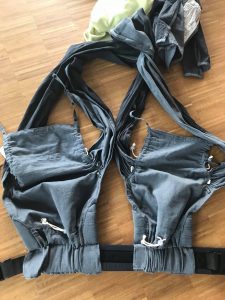
Images from Rosie Knowles (of LaKeta Kemp using two DidyClicks)
Front and Back Tandem Carries
Meh Dais and Half Buckles can also be used to carry two children, one on the front and one on the back. It is possible to tandem carry this way from a few weeks old. However, it can be scary and challenging to get a small baby safely on your back alone, just as with a woven wrap, so it is best to get professional support and guidance with this.
Pros and Cons of Meh Dais and Half Buckles
Pros
- They give the comfort and feel of woven wraps but with the convenience of a pre-made panel and the comfort and security of a waistband.
- Two carriers can be used for both front tandem carrying or front and back tandem carries. Each carrier can then be used individually as needed or by two caregivers.
- Meh Dais and Half Buckles can be used for a front and back tandem carry from newborn, with professional support.
Cons
- It can feel like a lot of fabric in one place with 4 straps being wrapped around you and two waistbands.
- There can feel like a lot of knots if using two carriers at once.
Two Ring Slings / Two MiniMonkey MiniSlings
This is a nice option for when you would like to have two individual carriers that can also be used at the same time. Two ring slings offer a front tandem carry like a Jasmine’s Hip Carry, however with two pairs of rings pressing against you it can dig in a bit. Some caregivers deal with this by placing the rings on the back with a flip in the fabric on the front, this can work well with practice but often involves a learning curve. Using two individual MiniMonkey MiniSlings can be a lot easier, it mimics the double front carrying option of the Twin MiniMonkey and works well for small babies. With heavier and older babies, the waistband of the Twin MiniMonkey can be useful for better weight distribution.
Pros and Cons of two ring slings or two MiniSlings

Pros
- Using two separate carriers means there is always the option of carrying one child at a time (or each if there is another caregiver).
- Two MiniSlings is a great hot weather option.
- Ring slings can give more adjustability than two MiniSlings.
Cons
- Two sets of rings can be hard work to adjust easily and be uncomfortable.
- The first baby can end up sliding under your armpit when putting the second baby in, but this does get easier with practice.
Two Buckle Carriers
There is a wide variety of buckle carriers that can be used when doing a front and back tandem carry when one baby fits well into the panel and is almost able to sit unaided. It always helps to explore all the different types of buckle carriers and see what would work for your family, as one type does not suit everyone. You may even choose to use different brands together.
Front tandem carries
There are a few buckle carries that can be used together for a tandem front carry, either off centre or hip carry. These are the Integra, the Ergo Embrace and the Izmi, as these have unpadded waistbands so there will be less of a large bulk around the caregivers middle. However, this can become very fiddly with all of the buckles and the straps across the shoulders. We would recommend booking an appointment with a consultant to make sure everyone is safe.
Front and Back tandem carries

Most brands of buckle carriers can be used for front and back tandem carrying, however it may be more comfortable to choose two with unpadded waist bands, for (example the Integra or the Izmi) as they will sit flat against the waist without too much bulk. Another option would be to use one unpadded and one padded waistband (for example a Tula or Lenny Lamb). This still keeps bulk to a minimum while increasing the feeling of support. There are so many variations you could use, so it is best to have a good look around and see what types of buckle carriers you think would suit you. Most sling libraries will stock a good range for you to try out.
Pros and Cons of two buckle carriers
Pros
- Two carriers offer a lot of adjustability.
- Each carrier can be used to carry children separately (sharing the load between caregivers, or if one child is in the buggy/walking!)
- Some carriers work well in combination.
Cons
- Two carriers can feel very fiddly with lots of buckles and straps.
- Carriers that have fixed position panels can be hard to move around the waist for two hip carries.

Mix and match options
Sometimes the best option is just to choose the things that work well for you on their own and see how it goes! The possibilities are endless when it comes to the mix and match approach, from a woven and a buckle together, to a Meh Dai on the back and a ring sling on the front.
Mix and match is often the easiest option when carrying children of different ages, making the most of the slings you already have. For example, a stretchy wrap or a close caboo is a fantastic option to use alongside another type of carrier when caring for a newborn baby and a toddler. The stretchy/Caboo should be put on first of all, and adjusted to fit the newborn snugly and safely. Baby is then taken out, leaving the stretchy/Caboo in place. This frees you up to then get your toddler safely onto your back in your chosen carrier (eg a woven or a buckle) without worrying about your baby during the process. As the stretchy/Caboo is “poppable” and has already been set up for your baby, once toddler is in place, baby can be quickly and easily popped back in (or out again, as needed, eg for a feed, or if your toddler has fallen asleep and baby needs a change or some play time).
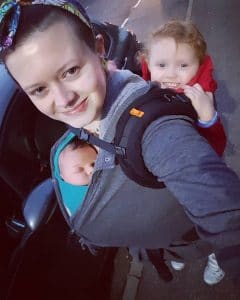

Pros and Cons of mix and match tandem babywearing
Pros
- There are many possibilities and a chance to be creative.
- This mix and match method can be very useful for using the slings you already have, rather than needing to buy more.
Cons
- It can feel like an overwhelming amount of choice; this is where sling libraries and consultants can offer guidance and get you off to a flying start.
Many families will opt for a sling and buggy combination with two or three children, but it is in fact possible to carry three children at once, as this hero mother demonstrates!
Summary
The most important thing to remember if you are considering using slings with your children, is to do what is best for your family. This will vary. It could be carrying children individually, one in a sling and one in a pushchair, or it could be tandem carrying. Every family is different, so what works for you might not be the best option for the next family, and what works for your friend might not be best for you.

In conclusion, we recommend becoming familiar with carrying one baby first and then progress to tandem carrying in whichever way you feel most comfortable with. If you are unsure about anything, get support from a trained professional, they will be more than happy to give you all the information they can (we love to do it!) and do their utmost to make sure that you are utilizing all the resources that you can.
Authors Jess Yarborough and Rosie Knowles

